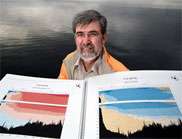Sea level on the rise – in real and virtual worlds

The climate system, and in particular sea level, may be responding more quickly to rising carbon emissions than climate scientists have estimated with climate models.
An international team of climate scientists has cautioned against suggestions that the Intergovernmental Panel on Climate Change (IPCC) has previously overestimated the rate of climate change.
The team, from six institutions around the world, reviewed actual observations of carbon dioxide, temperature and sea level from 1990 to 2006 and compared them with projected changes for the same period.
In a review published in the journal Science today, the authors found that carbon dioxide concentration followed the modelled scenarios almost exactly, that global-mean surface temperatures were in the upper part of the range projected by the IPCC, and that observed sea level has been rising faster than the models had projected and closely followed the IPCC Third Assessment Report upper limit of an 88 cm rise between 1990 and 2100.
The scientists noted that because the review period (1990-2006) was short, it would be premature to conclude that sea levels will continue to increase at the same rate in the future. However, they also said their findings show that previous projections have not exaggerated the rate of change but may in some respects have underestimated it.
Measurements of carbon dioxide through facilities such as the Australian Bureau of Meteorology’s Cape Grim observatory in Tasmania support the paper’s conclusions. The global average temperature estimates are collated separately by NASA’s Goddard Institute for Space Studies in the USA and the Hadley Centre and Climatic Research Unit in the UK. The sea level observations come from both coastal and island tide gauges and data provided by satellites.
Sea levels have risen largely due to warming of the ocean and the consequent thermal expansion and melting of non-polar glaciers and ice caps and the ice sheets of Antarctica and Greenland.
One of the authors of the review, Dr John Church of the Antarctic Climate & Ecosystems CRC and CSIRO, noted that any (or all) of the modelled contributions could be underestimated but that there is most uncertainty about the contribution made by ice-sheet melts. “Models of the potential contribution of the Greenland and Antarctic ice sheets need to be improved to include the potential of a relatively dynamic response,” Dr Church said.
Source: CSIRO



















